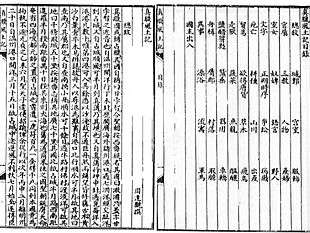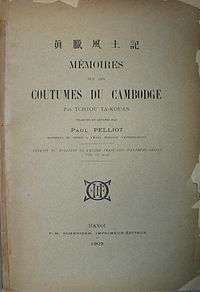The Customs of Cambodia

The Customs of Cambodia or A Record of Cambodia: the Land and Its People (Chinese: 真臘風土記) is the English translated name of the document written by the Yuan Chinese official Zhou Daguan (Chou Ta-kuan; French: Tcheou Ta-Kouan) during his stay at Angkor between 1296 AD and 1297 AD. Zhou's account is of great historical significance because it is the only surviving first person written record of daily life in the Khmer Empire. The only other written information available is from the inscriptions on temple walls.[1]
Chinese original work
The book is an account of Cambodia by Zhou who visited the country as part of an official diplomatic delegation sent by Temür Khan in 1296 to deliver "an imperial edict". It is not certain when it was completed, but it was written within 15 years of Zhou return to China in 1297. The work that survives today however is believed to be a truncated version, perhaps representing only around a third of the original size. A 17th-century bibliophile, Qian Zeng (錢曾), noted the existence of two versions of the work, one a Yuan Dynasty edition, the other included in a Ming Dynasty anthology called Sea of Stories Old and New (古今说海, Gu jin shuo hai). The Ming Dynasty version was described as "muddled and jumbled up, six or seven tenths of it missing, barely constituting a book at all". However, the Yuan Dynasty version is no longer extant, and the surviving versions appear to be largely based on the truncated Ming Dynasty one.[2]
Texts from the book were collected in various other anthologies. Excerpts were given in a lengthy compilation Boundaries of Stories (说郛, Shuo fu) first compiled at the end of Yuan Dynasty,[3] and a second version was published in early Qing Dynasty. Truncated text was also given in Lost Histories Old and New (古今逸史, Gu jin yi shi) from the Ming Dynasty, and this same text was used in other collections. A major modern Chinese versions of the book is an annotated edition, which was compiled by Xia Nai (夏鼐) from variants of the text found in 13 editions, completed in 1980 and published in 2000.[4]
The work was written in classical literary Chinese, however, there are occasionally words and sentence structures that appear to have been influenced by Zhou's Wenzhou dialect.[2]
Translations

Zhou's account was first translated into French in 1819 by Jean-Pierre Abel-Rémusat but it did not have much impact.[5] It was then retranslated into French by Paul Pelliot in 1902, and this translation was later partly revised by Pelliot and republished posthumously in 1951,[6] although Pelliot died before he could complete the comprehensive notes he had planned for Zhou's work. Pelliot's translation is highly regarded and it formed the basis of many later translations into other languages, for example into English by J. Gilman d’Arcy Paul in 1967 and Michael Smithies in 2001.[7][8]
In 2007, Sino-linguist Peter Harris, a Senior Fellow at the Center for Strategic Studies New Zealand, completed the first direct translation from Chinese to modern English, correcting many errors in previous translated English versions, with a new title A Record of Cambodia: the Land and Its People. Harris worked in Cambodia for many years and included modern photographs and maps directly relating to Zhou's original account. This book also includes more than 100 bibliographic references, two appendices, and a detailed index in English and Chinese.Harris also draws a series of parallels between the voyage of Zhou Daguan and the travels of Marco Polo. Marco Polo was Zhou's contemporary, however, according to Harris, Polo's travels contain a number of unusual omissions that beg further investigation.[9]
Content
The book gives descriptions of Yasodharapura, the capital city at the center of Angkor, and everyday palace life and protocols. It also describes various customs and religious practices, the role of women and slaves, trade and city life, agriculture, the Chinese in Cambodia, and other aspects of society in Angkor.[2] Also included are descriptions of the flora and fauna of the region, foodstuff, as well as unusual tales.
The descriptions in the book are generally considered to be accurate, but there are also mistakes, for example the local Hindu religious devotees were described erroneously by Zhou in Chinese terms as Confucians or Daoists, and the measurements of length and distance used are often less than exact.
On the Royal Palace:[10]
| “ | All official buildings and homes of the aristocracy, including the Royal Palace, face the east. The Royal Palace stands north of the Golden Tower and the Bridge of Gold: it is one and a half mile in circumference. The tiles of the main dwelling are of lead. Other dwellings are covered with yellow-coloured pottery tiles. Carved or painted Buddhas decorate all the immense columns and lintels. The roofs are impressive too. Open corridors and long colonnades, arranged in harmonious patterns, stretch away on all sides. | ” |
On Khmer Homes:[1]
| “ | The dwellings of the princes and principal officials have a completely different layout and dimensions from those of the people. All the outlying buildings are covered with thatch; only the family temple and the principal apartment can be covered in tiles. The official rank of each person determines the size of the houses. | ” |
On a royal procession of Indravarman III:[11]
| “ | When the king goes out, troops are at the head of [his] escort; then come flags, banners and music. Palace women, numbering from three to five hundred, wearing flowered cloth, with flowers in their hair, hold candles in their hands, and form a troupe. Even in broad daylight, the candles are lighted. Then come other palace women, bearing royal paraphernalia made of gold and silver... Then come the palace women carrying lances and shields, with the king's private guards. Carts drawn by goats and horses, all in gold, come next. Ministers and princes are mounted on elephants, and in front of them one can see, from afar, their innumerable red umbrellas. After them come the wives and concubines of the king, in palanquins, carriages, on horseback and on elephants. They have more than one hundred parasols, flecked with gold. Behind them comes the sovereign, standing on an elephant, holding his sacred sword in his hand. The elephant's tusks are encased in gold. | ” |
On the king's wardrobe:[1]
| “ | Only the ruler can dress in cloth with an all-over floral design…Around his neck he wears about three pounds of big pearls. At his wrists, ankles and fingers he has gold bracelets and rings all set with cat's eyes…When he goes out, he holds a golden sword [of state] in his hand. | ” |
On the women of Angkor:[1][12]
| “ | The local people who know how to trade are all women. So when a Chinese goes to this country, the first thing he must do is take in a woman, partly with a view to profiting from her trading abilities. | ” |
| “ | The women age very quickly, no doubt because they marry and give birth when too young. When they are twenty or thirty years old, they look like Chinese women who are forty or fifty. | ” |
Calendar
Zhou's account is very useful for determining that the 1st month of the Khmer calendar was "kia-to", called Karttika. None of the Khmer inscriptions uses month numbering, but of the three systems used later in Thailand, Karttika was called month 1 in parts of Lanna and was also sometimes so numbered in Laos. The astronomical new year, on the other hand, began in what would have been numbered month 6 (Caitra). This equation is confirmed when Zhou Daguan says he does not understand why they intercalate only in (their) month 9. On the scale being used here the 9th month is Ashadha, the only intercalary month in Thailand and Laos. (Ashadha is better known as 'month 8' since that is its Southern (Bangkok) equivalence.)
The use in Cambodia of Ashadha as the only intercalary month is not otherwise securely attested until the 1620s AD when a year (Saka 1539; IMA no. 9) is said to have a 2nd Ashadha when the old system did not have an extra month in that year. The inscription record between 1296 AD and 1617 AD is very patchy, but such records as survive from the first part of this interval appear to favour the older system of reckoning, suggesting that Zhou Daguan's informants were at the time of his visit in the minority.
See also
Footnotes
- 1 2 3 4 Cardiff de Alejo Garcia - Passing Notes - Smithsonian Magazine "History & Archaeology"
- 1 2 3 Zhou Daguan (2007). A Record of Cambodia. Translated by Peter Harris. University of Washington Press. ISBN 978-9749511244.
- ↑ Tabish Khair, ed. (2006). Other Routes: 1500 Years of African and Asian Travel Writing. Indiana University Press. p. 114. ISBN 978-0253218216.
- ↑ 周达观,夏鼐. 真臘風土記校注,西遊錄,異域志. 中华书局. ISBN 9787101020281.
- ↑ Jean-Pierre Abel-Rémusat: Description du royaume de Cambodge par un voyageur chinois qui a visité cette contrée à la fin du XIII siècle, précédée d'une notice chronologique sur ce même pays, extraite des annales de la Chine, Imprimerie de J. Smith, 1819
- ↑ Daguan Zhou; Paul Pelliot (1951). Mémoires sur les coutumes du Cambodge de Tcheou Ta-Kouan. Adrien-Maisonneuve.
- ↑ Chou Ta-Kuan, The Customs of Cambodia, transl. by John Gilman d'Arcy Paul, Bangkok: Social Science Association Press, 1967.
- ↑ Zhou Daguan, The Customs of Cambodia, transl. by Michael Smithies, Bangkok: The Siam Society, 2001.
- ↑ Zhou Daguan (2007). A Record of Cambodia. Translated by Peter Harris. University of Washington Press. ISBN 978-9749511244.
- ↑ Tabish Khair, ed. (2006). Other Routes: 1500 Years of African and Asian Travel Writing. Indiana University Press. p. 115. ISBN 978-0253218216.
- ↑ Andrew Forbes; David Henley; Colin Hinshelwood (2012). Angkor: Eighth Wonder of the World. Cognoscenti Books. p. 108. ASIN B0085RYW0O.
- ↑ Zhou Daguan (2007). A Record of Cambodia. Translated by Peter Harris. University of Washington Press. p. 70. ISBN 978-9749511244.
External links
| Chinese Wikisource has original text related to this article: |
- Zhou Daguan, A Record of Cambodia, transl. by Peter Harris, Silkworm Books, 2007. ISBN 978-974-9511-24-4 Amazon.com
- Zhou Daguan, The Customs of Cambodia, Siam Society, 2001. ISBN 978-974-8298-51-1 - Amazon.com
- Book review by Cambodia Daily: A Record of Cambodia - The Land and its People, 2007 edition
- Book review by Siam Society - A Record of Cambodia - The Land and its People, 2007 edition
- Book review by New Zealand Journal of Asian Studies: A Record of Cambodia - The Land and its People, 2007 edition
- Smithsonian Magazine - Passing Notes
- Smithsonian Magazine - Jewel of the Jungle